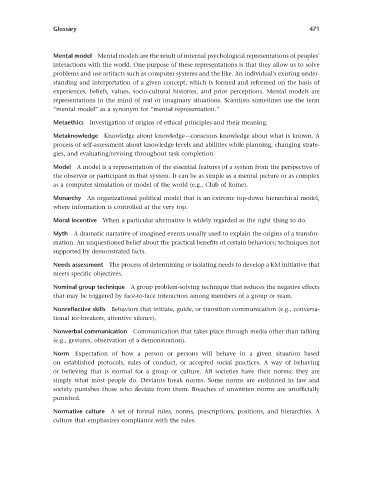Page 488 -
P. 488
Glossary 471
Mental model Mental models are the result of internal psychological representations of peoples ’
interactions with the world. One purpose of these representations is that they allow us to solve
problems and use artifacts such as computer systems and the like. An individual ’ s existing under-
standing and interpretation of a given concept, which is formed and reformed on the basis of
experiences, beliefs, values, socio-cultural histories, and prior perceptions. Mental models are
representations in the mind of real or imaginary situations. Scientists sometimes use the term
“ mental model ” as a synonym for “ mental representation. ”
Metaethics Investigation of origins of ethical principles and their meaning.
Metaknowledge Knowledge about knowledge — conscious knowledge about what is known. A
process of self-assessment about knowledge levels and abilities while planning, changing strate-
gies, and evaluating/revising throughout task completion.
Model A model is a representation of the essential features of a system from the perspective of
the observer or participant in that system. It can be as simple as a mental picture or as complex
as a computer simulation or model of the world (e.g., Club of Rome).
Monarchy An organizational political model that is an extreme top-down hierarchical model,
where information is controlled at the very top.
Moral incentive When a particular alternative is widely regarded as the right thing to do.
Myth A dramatic narrative of imagined events usually used to explain the origins of a transfor-
mation. An unquestioned belief about the practical benefi ts of certain behaviors; techniques not
supported by demonstrated facts.
Needs assessment The process of determining or isolating needs to develop a KM initiative that
meets specifi c objectives.
Nominal group technique A group problem-solving technique that reduces the negative effects
that may be triggered by face-to-face interaction among members of a group or team.
Nonrefl ective skills Behaviors that initiate, guide, or transition communication (e.g., conversa-
tional ice-breakers, attentive silence).
Nonverbal communication Communication that takes place through media other than talking
(e.g., gestures, observation of a demonstration).
Norm Expectation of how a person or persons will behave in a given situation based
on established protocols, rules of conduct, or accepted social practices. A way of behaving
or believing that is normal for a group or culture. All societies have their norms; they are
simply what most people do. Deviants break norms. Some norms are enshrined in law and
society punishes those who deviate from them. Breaches of unwritten norms are unoffi cially
punished.
Normative culture A set of formal rules, norms, prescriptions, positions, and hierarchies. A
culture that emphasizes compliance with the rules.

